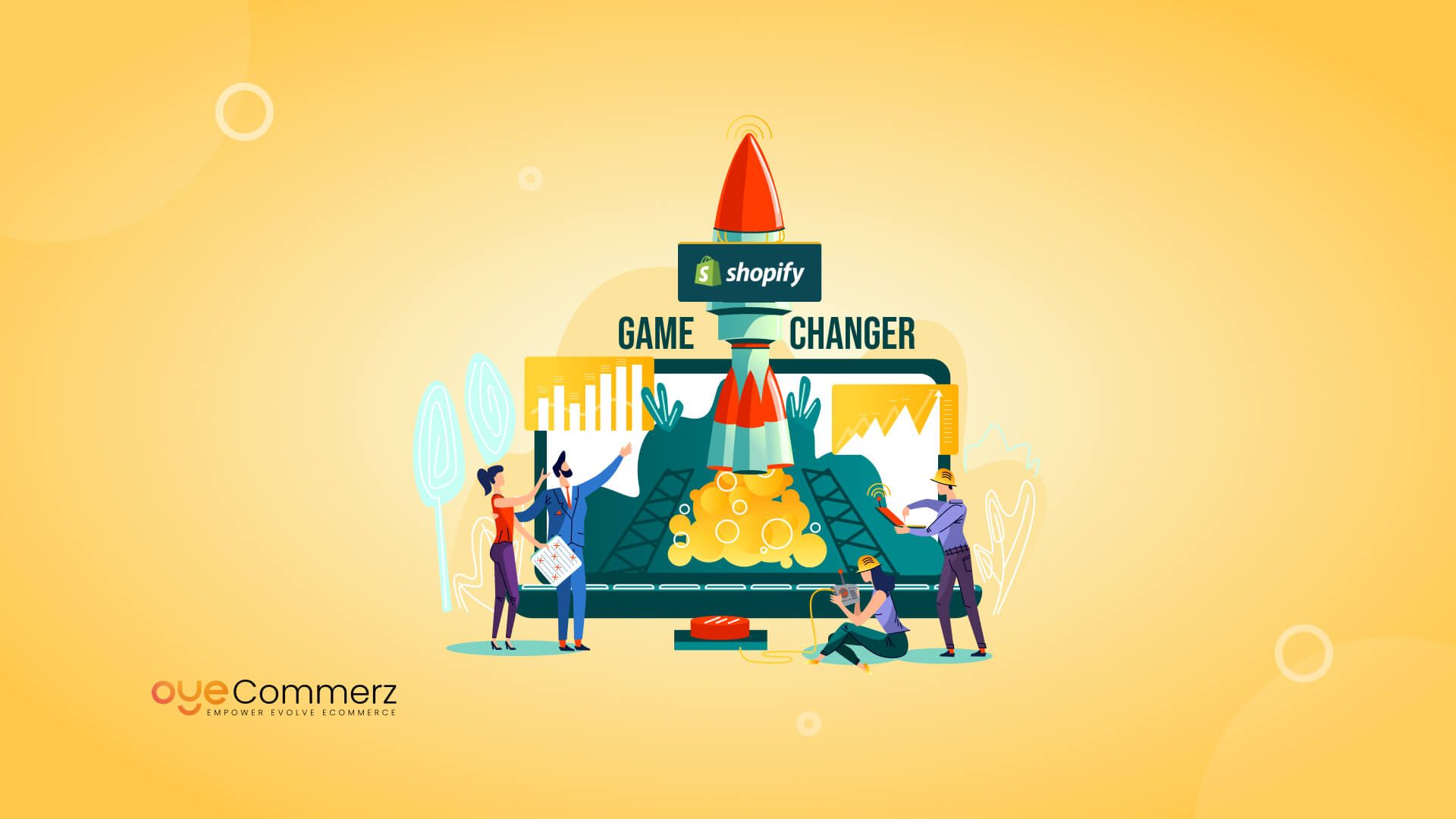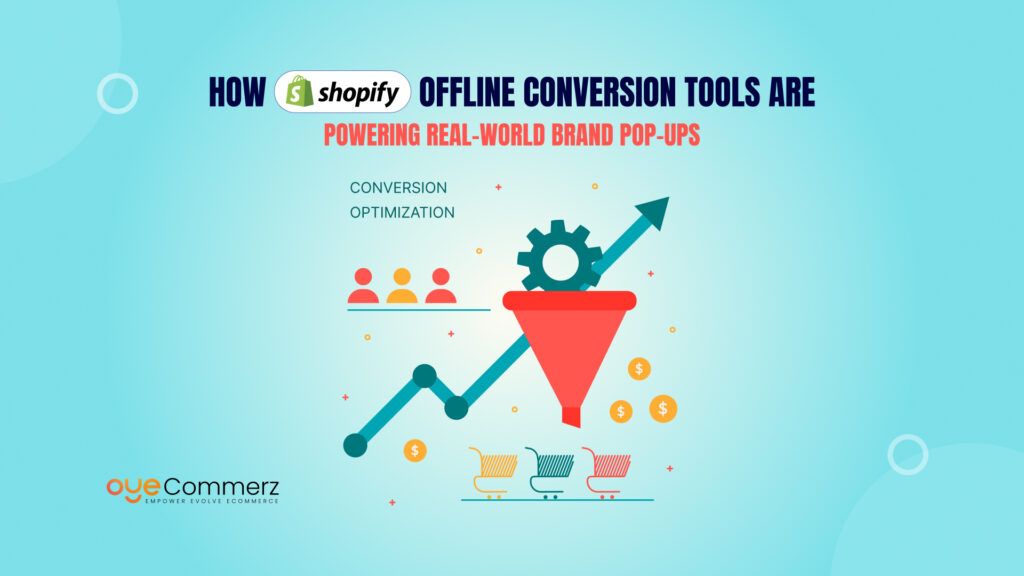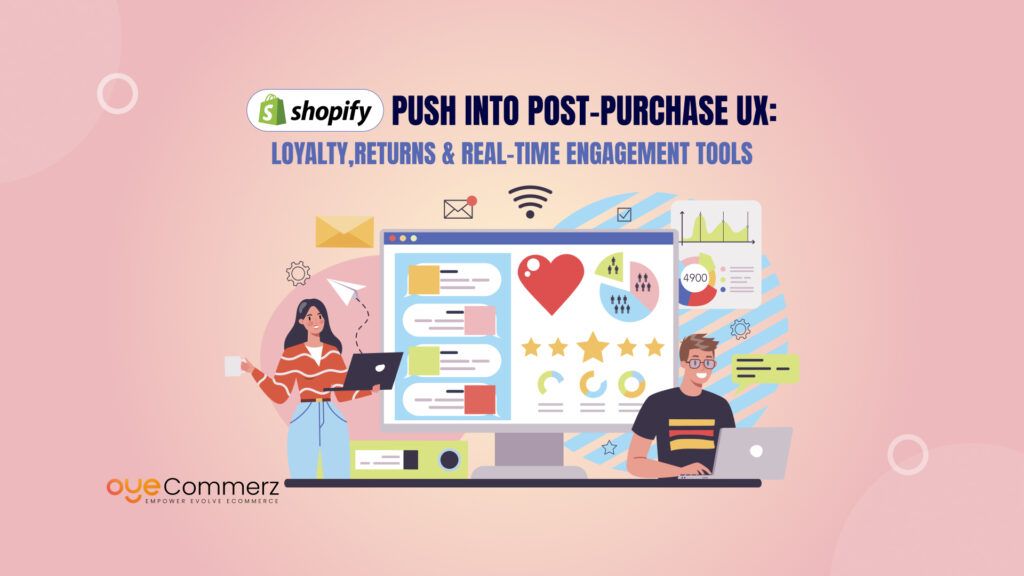Is your current eCommerce platform holding back your brand’s growth?
As your business scales, the tools and platforms you rely on can become roadblocks instead of enablers. Slow website performance, clunky interfaces, expensive maintenance, and lack of modern features are common frustrations for growing online brands. If this sounds familiar, it might be time to consider a change.
Enter Shopify, a leading eCommerce platform trusted by over 2 million businesses worldwide. Designed to be intuitive, scalable, and packed with features, Shopify empowers brands to focus on what matters most: delivering exceptional customer experiences and growing their bottom line.
This blog explores why Shopify Migration Services is a game-changer for brands seeking to unlock new opportunities. From its seamless design tools to robust integrations and unmatched scalability, Shopify has everything you need to future-proof your online business.
So, why settle for a platform that limits your potential when Shopify can transform the way you operate and thrive? Let’s dive in!
Table of Contents
ToggleWhy Should You Migrate to Shopify?
Migrating to Shopify can revolutionize your eCommerce business. Here’s a detailed breakdown of why Shopify is the go-to platform for growing brands:
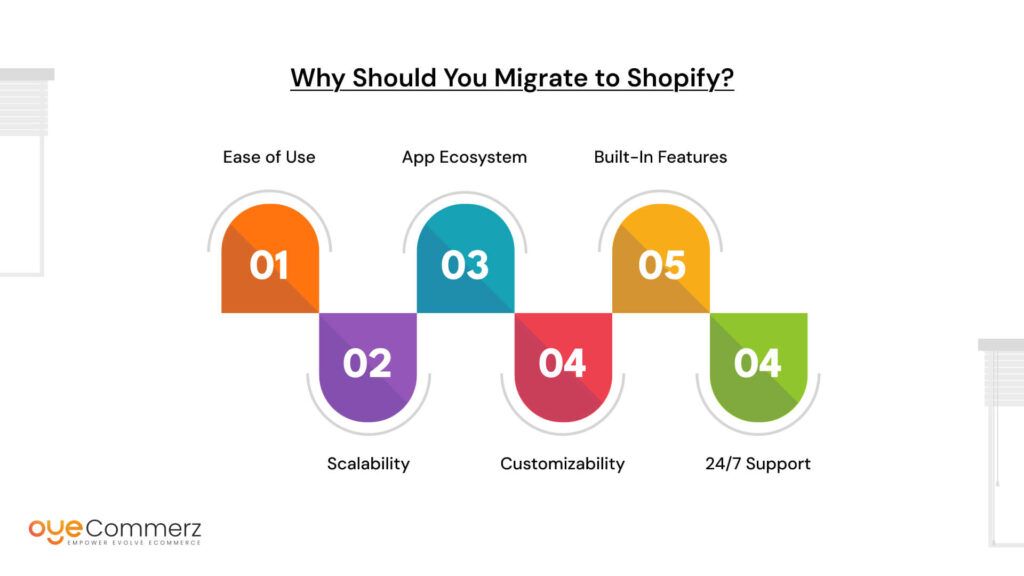
1. Ease of Use
Shopify is designed with user-friendliness in mind, making it an ideal platform for both tech-savvy and non-technical users.
- Intuitive Dashboard: Manage products, orders, customers, and analytics effortlessly from a single, well-organized dashboard.
- Simple Store Setup: Launching a Shopify store doesn’t require coding expertise. Pre-designed templates and step-by-step guides make setup quick and stress-free.
- Time-Saving Tools: Automate repetitive tasks, such as inventory tracking and email notifications, so you can focus on growing your business.
2. Scalability
As your business grows, Shopify grows with you.
- Flexible Plans: From startups to enterprise-level brands, Shopify offers pricing plans that suit every stage of your business.
- Robust Infrastructure: Shopify can handle high traffic volumes during peak sales periods without compromising speed or performance.
- Global Reach: With built-in tools for multi-currency and multilingual support, Shopify makes expanding into international markets seamless.
3. App Ecosystem
Shopify’s App Store is a game-changer for enhancing functionality.
- Over 9,000 Apps: From marketing tools and inventory management to customer service and advanced analytics, there’s an app for nearly every need.
- Easy Integration: Most apps integrate seamlessly into your store, allowing you to add new features without disrupting your operations.
- Customization: Tailor your store experience with apps that suit your niche, such as subscription services, loyalty programs, or advanced search functionality.
4. Customizability
Your store should reflect your brand identity, and Shopify provides the flexibility to make it happen.
- Themes for Every Niche: Choose from a wide variety of free and premium themes designed for different industries.
- Advanced Design Options: Customize themes with Shopify’s drag-and-drop editor or tweak the code for a more personalized look.
- Responsive Design: All themes are mobile-friendly, ensuring an optimized shopping experience across devices.
5. Built-In Features
Shopify’s out-of-the-box features eliminate the need for costly third-party tools.
- Hosting: Fast and reliable hosting is included, so you don’t have to worry about managing servers.
- Payment Gateways: Shopify supports over 100 payment options, including Shopify Payments, PayPal, and Stripe.
- SEO Tools: Improve your store’s visibility with built-in SEO features like customizable meta tags, sitemaps, and clean URL structures.
- Abandoned Cart Recovery: Re-engage customers who didn’t complete their purchase with automated recovery emails.
6. 24/7 Support
Shopify ensures that help is always just a click away.
- Round-the-Clock Assistance: Access support anytime through live chat, email, or phone.
- Extensive Knowledge Base: Shopify provides a library of guides, tutorials, and FAQs to help troubleshoot common issues.
- Community Support: Join the Shopify Community Forum to connect with other merchants, share tips, and seek advice.
Shopify’s combination of ease of use, scalability, rich app ecosystem, and reliable support makes it a powerful platform for growing online brands. By migrating to Shopify, you’ll not only streamline your operations but also position your business for long-term success.
Signs It’s Time to Migrate
Choosing the right time to migrate to Shopify is crucial for ensuring your business continues to thrive. Here are some telltale signs that it’s time to make the move:
1. Slow Performance
Lagging website speed can harm your brand more than you might think.
- Impact on Customer Retention: Studies show that even a one-second delay in page loading time can result in a 7% reduction in conversions. Customers expect lightning-fast websites, and anything less can lead to abandoned carts and lost sales.
- Search Engine Rankings: Slow-loading sites are penalized by search engines like Google, impacting your store’s visibility and organic traffic.
- Compromised User Experience: Slow navigation frustrates customers, reducing engagement and repeat business opportunities.
2. Limited Scalability
Your current platform might be great for where you started, but can it grow with you?
- Traffic Spikes: Many platforms struggle to handle increased traffic during peak seasons or flash sales, resulting in downtime or crashes.
- Product Expansion: If your platform limits the number of products or categories you can add, it can hinder your ability to scale your offerings.
- Global Reach Challenges: Expanding into international markets may require features like multi-currency support, multilingual capabilities, and region-specific integrations features that outdated platforms often lack.
3. High Maintenance Costs
Older platforms often require significant time and money to keep running smoothly.
- Frequent Updates: Constant updates for plugins, extensions, or custom code can drain your resources.
- Developer Dependency: If you rely heavily on developers for basic updates or fixes, your operational costs can skyrocket.
- Hidden Fees: Many platforms have hidden costs for hosting, SSL certificates, or third-party tools that add up over time.
4. Integration Problems
Seamless integrations are essential for modern eCommerce operations.
- Third-Party Tools: Outdated platforms often lack compatibility with popular tools like advanced analytics, email marketing software, or CRM systems.
- Manual Workarounds: If you’re spending hours on manual data entry or reconciling systems that don’t sync, it’s a clear sign that your platform isn’t cutting it.
- Limited Innovation: Newer tools and technologies may not integrate with older platforms, leaving you behind the competition.
5. Security Concerns
ECommerce security is non-negotiable in today’s digital landscape.
- Data Breaches: Older platforms may lack advanced security protocols, putting your customer and business data at risk.
- PCI Compliance: Ensuring secure transactions requires compliance with industry standards, which many legacy platforms fail to meet.
- Reputation Damage: A single security breach can result in lost customer trust and damage to your brand’s reputation.
If your business is experiencing any of these challenges, it’s a clear sign that your current platform is no longer serving your needs. Migrating to Shopify can help you overcome these roadblocks with its fast, secure, and scalable infrastructure, ensuring your business is ready for long-term success.
Benefits of Migrating to Shopify
Migrating to Shopify isn’t just about switching platforms, it’s about upgrading your eCommerce business to deliver better experiences, increase sales, and stay ahead of the competition. Here’s how Shopify benefits your brand:
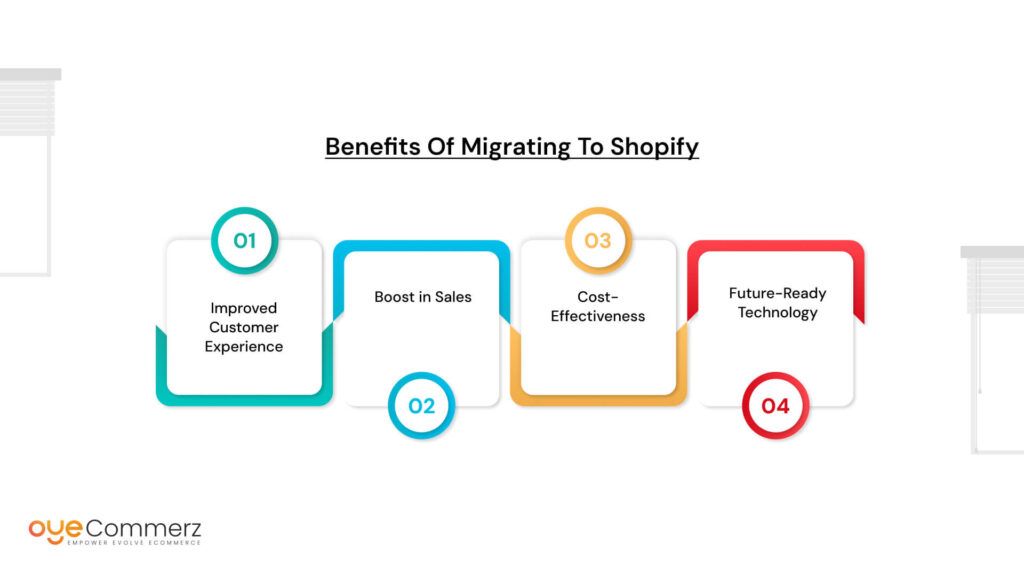
1. Improved Customer Experience
Providing a seamless and enjoyable shopping experience is key to retaining customers and driving repeat purchases. Shopify makes this effortless:
- Faster Loading Times: Shopify is hosted on a robust infrastructure designed for speed, ensuring your store loads quickly even during high-traffic periods. Faster loading times mean fewer abandoned carts and higher customer satisfaction.
- Mobile Optimization: With mobile shopping accounting for a significant portion of online sales, Shopify’s themes are fully responsive. This ensures a smooth shopping experience across all devices, from desktops to smartphones.
- Seamless Navigation: Shopify’s intuitive design tools allow you to create clean, user-friendly navigation, making it easier for customers to browse and find products.
2. Boost in Sales
Shopify’s features and integrations are tailored to maximize conversions and sales.
- Advanced Marketing Tools: Shopify integrates with leading marketing platforms, helping you run effective email campaigns, social media ads, and more. Built-in SEO features also improve your store’s visibility on search engines.
- Upselling and Cross-Selling: With apps and features like product recommendations and bundles, you can increase average order value effortlessly.
- Abandoned Cart Recovery: Shopify automatically sends reminders to customers who left items in their cart, helping you recover lost sales.
- Multiple Payment Options: Shopify supports over 100 payment gateways, ensuring customers can pay using their preferred method, which reduces cart abandonment.
3. Cost-Effectiveness
Shopify’s all-in-one pricing structure helps you save money and streamline operations.
- Integrated Features: Shopify offers hosting, SSL certificates, payment gateways, and security features as part of its plans. This eliminates the need for third-party services and the extra costs that come with them.
- Affordable App Ecosystem: While many platforms require custom development for additional features, Shopify’s app store provides affordable, plug-and-play solutions for various needs.
- Low Maintenance Costs: Say goodbye to spending hours or money on platform updates, bug fixes, and server management. Shopify handles these for you.
4. Future-Ready Technology
Shopify keeps your store up-to-date with the latest technology and innovations.
- Regular Updates: Shopify rolls out new features and updates regularly, so your store always benefits from the latest advancements in eCommerce technology.
- Scalable Infrastructure: Whether you’re running a small boutique or an enterprise-level store, Shopify’s infrastructure is built to handle growth.
- Support for Emerging Trends: Shopify enables you to adopt new trends, such as voice commerce, AI-powered recommendations, and AR shopping experiences, with minimal effort.
Migrating to Shopify equips your store with the tools and features needed to thrive in a competitive eCommerce landscape. From improving customer satisfaction to boosting sales and saving costs, Shopify ensures your business is not just surviving but thriving for the long term.
The Shopify Migration Process Explained
Migrating to Shopify might seem daunting, but with a structured process, it can be seamless and efficient. Here’s a detailed step-by-step explanation of the migration journey:
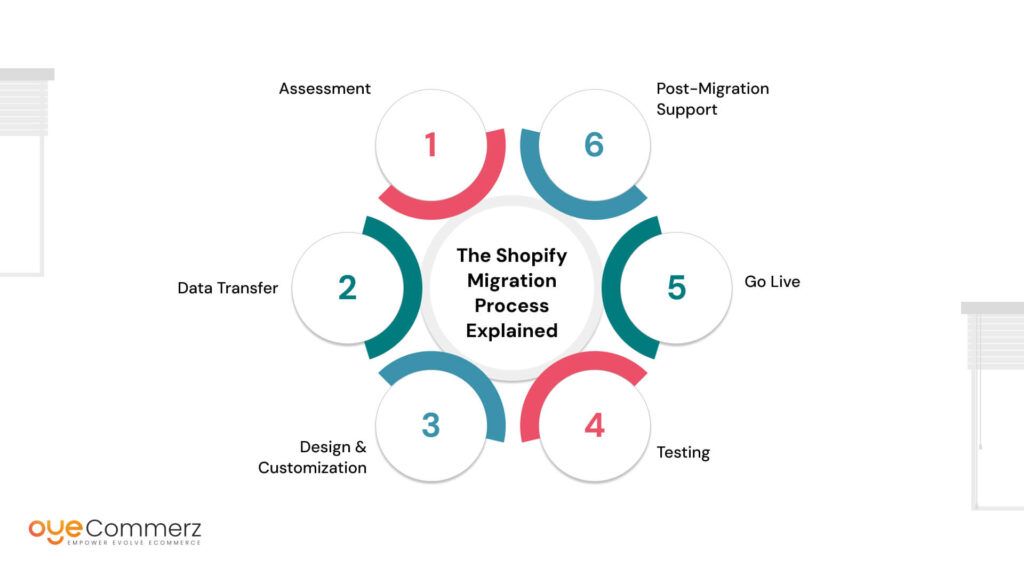
1. Assessment
The first step is to analyze your current platform and identify your requirements.
- Audit Your Store: Evaluate your existing website’s structure, data, and performance. Identify what’s working and what needs improvement.
- Define Goals: Determine what you aim to achieve with the migration—improved performance, scalability, or better user experience.
- Prioritize Features: Identify must-have features and functionalities for your Shopify store, such as apps, themes, or integrations.
2. Data Transfer
Moving your store’s data securely and accurately is critical.
- Exporting Data: Extract all essential information from your existing platform, including product details, customer data, order history, and website content.
- Data Mapping: Structure the data to fit Shopify’s format, ensuring compatibility and consistency.
- Importing to Shopify: Use migration tools or partner with experts to upload your data securely into your new Shopify store. Double-check for accuracy to avoid missing or incorrect entries.
- SEO Preservation: Implement proper URL redirects to maintain your current search engine rankings and prevent broken links.
3. Design & Customization
This is where your Shopify store starts to reflect your brand.
- Choose a Theme: Shopify offers a variety of themes for different industries, both free and premium. Select one that aligns with your brand’s aesthetics and goals.
- Customization: Use Shopify’s drag-and-drop editor to personalize your store. Adjust colors, fonts, and layouts to match your branding.
- Advanced Customization: If needed, developers can tweak the code to create a fully bespoke store that stands out from the competition.
4. Testing
Before launching, ensure everything is functioning as expected.
- Functional Testing: Test all key features, such as payment gateways, product search, checkout processes, and contact forms.
- Integration Testing: Verify that third-party apps, plugins, and tools are working seamlessly with your Shopify store.
- Mobile and Cross-Browser Testing: Check your store’s responsiveness across devices and browsers to ensure a consistent experience for all users.
- Performance Testing: Evaluate page loading speeds and overall site performance to confirm optimal functionality.
5. Go Live
Launching your Shopify store is an exciting milestone.
- Pre-Launch Checklist: Review all data, content, and settings to ensure everything is accurate.
- Domain Connection: Link your custom domain to Shopify. This ensures a smooth transition for customers visiting your store.
- Soft Launch: Consider launching your store quietly to test it with a small group before making it live for the public.
- Announce Your Launch: Once confident, go public! Inform your customers via email, social media, and other channels about your upgraded store.
6. Post-Migration Support
After the launch, it’s essential to monitor and optimize your store’s performance.
- Monitoring: Track key metrics like traffic, sales, and customer feedback to identify any issues early.
- Troubleshooting: Address any bugs or glitches promptly with Shopify’s 24/7 support or your migration partner.
- Training: Provide training for your team to familiarize them with Shopify’s interface and features.
- Ongoing Optimizations: Regularly update your store’s content, test new features, and use Shopify’s analytics to make data-driven improvements.
By following these steps, migrating to Shopify can be a smooth process that sets your business up for long-term success. A well-executed migration ensures your new store operates efficiently, delights customers, and supports your growth goals.
Overcoming Common Migration Concerns
Migrating to Shopify can raise concerns about potential risks, but with proper planning and execution, these challenges can be effectively addressed. Here’s how to overcome the most common migration concerns:
1. Data Loss
Losing critical data such as product listings, customer information, or order history can be a major worry during migration.
- Comprehensive Data Backup: Before starting the migration, create a full backup of your current store’s data to ensure nothing is lost.
- Secure Data Transfer: Use migration tools or partner with experts who follow best practices to transfer data securely and accurately.
- Validation and Testing: After migration, validate the transferred data by cross-checking product details, customer information, and order history to ensure completeness and accuracy.
- Data Mapping: Properly map fields between your old platform and Shopify to prevent errors or misaligned information.
2. SEO Impact
Preserving your website’s search engine rankings is critical to maintaining traffic and visibility post-migration.
- URL Redirects: Implement 301 redirects for all existing URLs to their new Shopify counterparts to prevent broken links and ensure continuity.
- Meta Tags and Descriptions: Transfer existing meta titles, descriptions, and keywords to Shopify to maintain your SEO strategy.
- Customizable SEO Features: Leverage Shopify’s built-in SEO tools to optimize page titles, product descriptions, and image alt text.
- Monitor Rankings: Post-migration, monitor your search engine rankings and make necessary adjustments to stay competitive.
3. Downtime
Minimizing downtime during migration is crucial to ensure uninterrupted business operations.
- Staged Migration: Migrate in stages, starting with a test environment before moving to the live site. This allows you to catch and resolve any issues early.
- Soft Launch: Consider launching the new Shopify store in a controlled environment to test functionality before fully going live.
- Expert Assistance: Work with migration specialists who can plan and execute the process efficiently to reduce or eliminate downtime.
- Hosting and Infrastructure: Shopify’s robust hosting ensures that your store remains live and accessible even during high-traffic periods.
4. Learning Curve
Transitioning to a new platform can feel intimidating, especially for store owners and teams unfamiliar with Shopify.
- Intuitive Interface: Shopify’s user-friendly dashboard makes it easy for anyone to manage products, orders, and customer data without technical expertise.
- Onboarding Resources: Shopify offers extensive guides, tutorials, and step-by-step documentation to help you and your team get up to speed quickly.
- 24/7 Support: Access Shopify’s customer support through live chat, email, or phone to address any questions or concerns during the transition.
- Hands-On Training: If needed, invest in training sessions or workshops to familiarize your team with Shopify’s features and tools.
By proactively addressing these concerns, you can ensure a smooth migration process. With the right approach and support, your move to Shopify will not only mitigate risks but also unlock new opportunities for growth and efficiency.
Why Partner with Oyecommerz for Your Migration?
Migrating to Shopify can be a complex process, but with Oyecommerz as your trusted partner, you can ensure a smooth, efficient, and stress-free transition. Here’s why businesses choose Oyecommerz for their Shopify migration needs:
1. Expertise in Seamless Migrations
At Oyecommerz, we specialize in helping businesses move their online stores to Shopify without disruptions.
- Proven Process: Our streamlined migration process is designed to handle every aspect of your transition, from data transfer to design and launch.
- Tailored Solutions: We understand that every business is unique. That’s why we create customized migration strategies to meet your specific needs and goals.
- Technical Excellence: With a team of Shopify experts, we have the skills to handle even the most complex migrations, including custom integrations and advanced functionalities.
2. Minimizing Downtime and Preserving SEO
We prioritize keeping your business running smoothly and maintaining your online visibility throughout the migration.
- Downtime-Free Transition: Our team carefully plans every step of the migration to minimize disruptions, ensuring your customers can continue shopping without interruption.
- SEO Preservation: We implement 301 redirects, transfer metadata, and optimize your Shopify store to ensure your search engine rankings and organic traffic remain intact.
- Testing and Validation: Before going live, we rigorously test your store to ensure all features and integrations are functioning perfectly.
3. Proven Track Record of Success
Oyecommerz has a history of delivering successful Shopify migration projects for businesses across various industries.
- Diverse Portfolio: From small startups to established enterprises, we’ve helped brands of all sizes achieve their eCommerce goals.
- Client Testimonials: Our clients rave about our expertise, professionalism, and ability to deliver results on time and within budget.
- Case Studies: We proudly showcase examples of businesses that have grown and thrived after partnering with us for their Shopify migration.
Let’s Take Your Business to the Next Level
Ready to experience the benefits of Shopify for your online store? Partner with Oyecommerz and take the first step toward a better, more scalable eCommerce future.
- Free Consultation: Contact us today to discuss your migration needs and learn how we can help.
- Get Started Now: Reach out via email or schedule a call with our experts to begin planning your seamless migration to Shopify.
By choosing Oyecommerz, you’re not just migrating to Shopify you’re unlocking new growth opportunities with a team that truly understands your business. Let us help you make the move and set your brand up for success!
Ready to Migrate to Shopify ? Let Us Help You Make the Switch!
Conclusion
Shopify Migration Services isn’t just a platform change, it’s a transformative step toward unlocking your brain’s full potential. As a leading eCommerce solution, Shopify provides the tools and scalability needed to grow your business, streamline operations, and deliver exceptional customer experiences.
While the idea of migration can seem daunting, it doesn’t have to be stressful. With the right partner, like Oyecommerz, the process becomes smooth, efficient, and entirely focused on helping you achieve your business goals. From ensuring data security to preserving SEO rankings and minimizing downtime, we’re here to guide you every step of the way.

